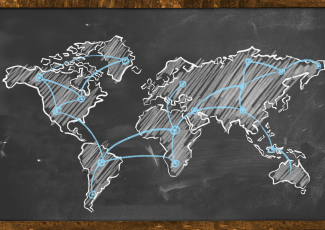Asking the Tough Questions
By Corey Murray
April 22, 2014
Report poses 12 intriguing questions facing community college leaders, and some of our sector’s most respected voices respond.
When the American Association of Community Colleges (AACC) released Reclaiming the American Dream: Community Colleges and the Nation’s Future back in 2012, the report forced the nation’s two-year career and technical colleges to face several hard — some might say brutal — truths, from poor graduation rates to a growing skills gap.
While community colleges were finally receiving the national recognition they so richly deserved, the document revealed that the large majority of institutions were woefully ill equipped to serve students in a changing and increasingly challenging global economy. The report offered seven recommendations for colleges to “redesign, reinvent and reset” themselves for 21st-century success.
At its annual convention in Washington, D.C., earlier this month, AACC released Empowering Community Colleges to Build the Nation’s Future: An Implementation Guide. The culmination of a year’s worth of research and work by more than 120 community college leaders, the new guide highlights promising practices in the association’s quest to embrace the urgency for change — whether through improved completion rates, more effective college-industry partnerships, revamped remedial education courses or other means defined in its 2012 report.
The findings — along with the many case studies that accompany them — should fuel a heady discussion about what community college leaders can and cannot do as they make changes on their campuses. But the ideas are far from the only ones worthy of consideration.
Just a few hours after community college leaders convened for the release of AACC’s new implementation guide, educators and other stakeholders met to discuss the results of another illuminating report — this one courtesy of the Roueche Graduate Center at National American University.
Compiled by George Lorenzo, writer and editor of the The SOURCE on Community College Issues, Trends & Strategies, the document poses “12 important questions for 16 community college leaders” on a diverse range of topics, from security and crisis management to international students and immigration reform to workforce education and the skills gap.
Below are some of the insights offered by community college leaders in that report.
On the increasing importance of security and crisis management:
“I am much more engaged as a college president in the nuts and bolts of emergency response, says Karen Stout, president of Montgomery County Community College in Pennsylvania. “I recently sat through an active shooters simulation and really got a sense over a four-hour period of time in a really intense environment what it would be like to have to answer any number of questions that would arise in dealing with an emergency like that. When I first started as a president, I don’t think we ever thought that we would be dealing with some of the scenarios that we’re dealing with in some of these tabletop exercises.”
Just how useful is all that preparation and training?
“Everybody is doing a lot more training, simulations, and preparation for the really big disasters, such as a shooting on campus or incidents of that type,” says Sandy Shugart, president of Valencia College in Florida. “I’m not sure how effective all that will be in the end. In some ways we’re whistling in the dark. When the incidents actually occur, very little of what you train for and plan for actually happens. But it’s better than doing nothing.”
On meeting the needs of international students:
“I think a lot of community college presidents are looking to that market for potential enrollments, and we think about that market more from the perspective of adding value to our students’ experience in a global society,” says Ken Ender, president of Harper College in Illinois.
“More than 2,500 international students enrich our campuses and contribute to our goal of preparing global citizens. International students are active in clubs and student government and successfully transfer to prestigious universities,” says Linda Thor, chancellor of the Foothill-De Anza Community College District in California. “To recruit and serve international students requires dedicated staff at home and abroad.”
What about the battle over immigration? How will that impact our efforts to serve this population?
“Each state will make its own policy,” said Terry O’Banion, president emeritus and senior fellow of the League for Innovation in the Community College and one of the sectors foremost authors. “Some will welcome all immigrants, keeping with the ‘open-door philosophy,’ and others will reject or make it harder for immigrants to enroll.” O’Banion says, “The community college could become the new Ellis Island as a conduit to help assimilate immigrants, as well as the community focal point for recognizing and celebrating the rich cultures that immigrants bring” — but only if the American political system, which seems intent to “kick the immigration issue around for a long time” allows that to happen.
On efforts to redesign remedial education:
“Sometimes putting people in classes and having them go for 16 weeks may be less important than a few abilities to interact with a counselor over shorter periods of time or with some information technology programs that they can work on at their own pace,” says James Jacobs, president of Macomb Community College in Michigan. Though he adds, “Having to analyze this and having to be successful with large numbers of students is a huge problem for all institutions.”
On the skills gap:
“One of things I see for community colleges is us becoming assessment centers where people can get stackable credentials and bring a portfolio together,” says John J. Sygielski, president of HACC, Central Pennsylvania’s Community College. “I think it is going to be the community college’s role to be able to go through all that and provide some type of seal of approval that potential employees can take with them to an employer.”
Is it possible to meet these needs with a finite number of resources?
“We are struggling to with the achievement gap,” says Sygielski. “We are putting resources there, getting involved in various programs and bringing nonprofits together, facilitating those discussions so that we can help these students — but there is never enough resources, there is never enough time, and there is never enough personnel. We are trying to figure out how to do it in a groups setting as well as how to do it in a way that more individuals can get the wraparound services they need.”
What about workforce development? How can colleges and businesses continue to work together?
“We have to think about manufacturing. When you start thinking about manufacturing, you get into things like CNC machining, along with the service side and growing needs,” says Lee Lambert, chancellor of Pima Community College in Arizona. “Once you build something, it has to be maintained. So our automotive programs, our aviation technology programs, all of those will see greater demands as opposed to the other way around. It is going to present wonderful opportunities for community colleges. But the other side of that is they’re expensive to maintain. And not only that, there is also the faculty piece — because our faculty are also aging, and we have to replace them.”
On the power of partnership:
“The common thread through so much of this discussion is partnership and alignment with the business community,” says Eduardo Padron, Miami Dade College president. “It’s absolutely necessary given the nature of the marketplace today. And while it’s true that community colleges have established themselves as the traditional supplier of heath care workers, police, fire and emergency medical personnel, the nature of the marketplace has opened up opportunities across the board for those institutions which can be nimble in responding to new demands.”
Want more answers from these and other community college leaders? Download the full report.






